Edward 1: The emergence of the English castle.
The British countryside is literally riddled with castles and their often ruinous remains. From imposing Norman Towers to picturesque pleasure palaces, theres about as many castles as there are sheep. Well maybe not England, but perhaps in Wales.
No person is more synonymous with building castles than one of Englands most notorious kings, Edward 1. Also knows as Edward Longshanks because of his gangly stature. Thanks to Hollywood, Edward is notorious for having Mel Gibson hanged, drawn and quartered. I should probably clarify that I’m referring to the infamous William Wallace of Scotland. Quite appropriately known as the hammer of the Scots, Edward is also notorious for his treatment of the Welsh, and their sheep. Probably not the sheep to be honest.
Throughout his reign, and that of his father Henry iii, Edward was engaged in a bitter Territorial struggle with the Lords of Wales, in particular the self proclaimed Prince of Wales Llewelyn ap Gruffod. Relations between the English and Welsh had been strained for years, but in the latter part of the 13th Century Edwards tolerance of Llewelyn came to an end and things got messy.
It is here then that Edward embarked on one of the most ambitious building projects ever seen in medieval Europe. In order to finally beat the Welsh into submission he constructed an iron ring of 8 bloody massive castles. Castles on this scale had never been seen before in Britain and we can only imagine the effect they must have had on the locals.
From the relatively modest garrison at Harlech, to the monstrous unfinished Palace at Beaumaris, were taking a look at the mighty Castles of Edward i
Prior to William the Conquerors invasion of England in 1066, Castles as we know them today didn’t really exist in Britain.
The castle was very much a Norman import and they were constructed as a means of the Normans being able secure their hold on England. The first fortifications were known as motte and bailie castles. A huge man made mount or ‘motte’ would be constructed and a wooden fort would be erected on top of it. A wooden enclosure known as a bailie would then be situated at the bottom. Clifford’s tower in York is a good example of a motte and bailie castle. Sure the wooden fort has been replaced with a stone one and the bailie no longer exists, but you get the picture.
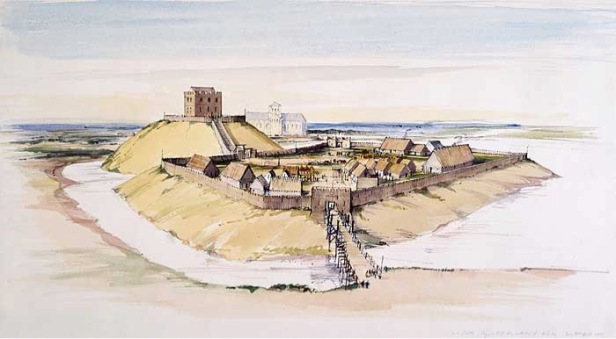
These simple castles were ideal as they were relatively cheap and quick to build. As basic as they were, nothing like this had been seen before so they must have made quite an impression on the English population.
Although motte and bailie castles were being constructed well into the 12th Century, the Normans began using stone in the immediate few years after 1066. Some motte and bailie castles were converted to stone and the idea of the self contained stone keep began to emerge. As soon as 1078 Construction of the White Tower at the Tower of London began. Nothing on this scale had been attempted since the Romans and we can imagine that the local population were utterly gobsmacked. Even today the White Tower is an imposing structure.
These massive stone keeps are synonymous with the Normans and demonstrate how nervous William and his Lords must have been following the invasion. The English did not merely bow down after the Battle of Hastings and these impressive stone keeps are all part of Williams desire to further strengthen his hold on England and emphasise his authority as ruler. Rochester and Colchester Castles are further examples of early Norman Stone keeps. Colchester however stands at only half of its original height.

Castles were built to this design for many years and it was not until the 13th Century that things changed. The strong castle keep design lost favour and the castles of new were built to a much more sophisticated design. The new concentric design advocated the idea of having multiple layers of defence, or walls within walls. And this leads us nicely onto King Edward, or rather it will do when I tell you how this new castle design emerged.
So, flash back to 1066. The Normans have killed a few Anglo Saxons at the battle of Hastings and the English King Harold Godwinson has been killed, allegedly after receiving an arrow through the eye. Nasty. The conquerors spread out through England, putting down English resistance and building as many as 1000 motte and bailie castles. They are very much securing the country and asserting their authority. Now, the boarder region between England and Wales had always been hotly contested and William the conqueror decided to formally subdue these boarder lands by creating creating semi independent lordships which he gave to his mates. The lords who settled here were technically not answerable to the English King and were free to rule as they saw fit. This boarder region became known as the ‘March’ after the Anglo Saxon word for boundary, and the Marcher Lords were at almost constant conflict with their Welsh neighbours.
Fast forward to the 13th Century. Relations between England and Wales are at breaking point.
Edwards father Henry has secured new territories in Northern Wales but has become distracted due Civil unrest in England. Llewelyn manages to claw back his territories in Gwynedd and Henry has no choice but to sign the Montgomery Peace Treaty in 1267. Under this he formally grants Llewelyn the title ‘Prince of Wales’ and in return Llewelyn agrees to do homage to Henry and pay him a hefty fine.
In spite of this new treaty, The Marcher Lords continue to act independently and continue to scrap with their Welsh neighbours. In particular, Marcher Lord Gilbert de Clair continues in his efforts to expand his boarders and sporadic warfare ensues. Set against this background or conflict Britains first ever concentrically designed castle begins to take shape.
Commissioned by Gilbert de Clair, the massive fortress at Caerphilly cost a gargantuan £19000 to built. Even the King of England would have struggled to have afforded this. This new state of the art concentric design had never been seen before and the fortification consisted of two separate sets of perimeter walls, surrounded by artificial lakes. The castle itself sits on an island and would have been highly defensive. Caerphilly was considered the finest castle in Europe and even today it stands as the second largest castle in Britain. So impressed was the young Prince Edward that all of his future castles would follow this sophisticated design.

When Edward succeeded to the English throne in 1272, he inherited a country brought to its knees by civil war. He quickly embarked on a program of reform, bringing to justice corrupt sheriffs and bailiffs and enforcing law and order. He also set about restoring the authority of the crown. The citizens of London had very much been a pain in Edwards derrière and as such he sought to subdue the local population by vastly updating his defences at the Tower of London. A new set of castle walls were added and new moat was dug around the complex. The castles towers and gate houses were also greatly improved and a new mighty entrance was constructed. The tower of London now replicated the concentric defences at Caerphilly and the castle we see today is largely a result of Edwards vision.
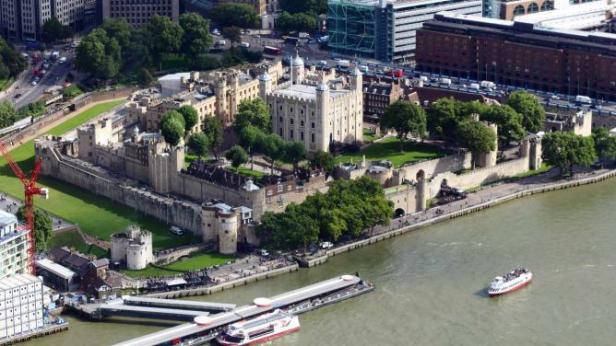
On the issue of Wales, Edward had lost patience. The Prince of Wales Llewelyn ap Gruffod was not playing ball and Edward declared war. In 1276 the English invaded Wales with a three pronged attack. Edward personally had his sights set on Llewelyn’s principality of Gwynedd and led a northern army out of Chester. The king however had no remaining bases in Wales, largely thanks to his father, and therefore commissioned three new castles.
Edward first marched to Flint where he construction his first castle. Built upon naturally defensible marsh lands, the fortification was built to a very unique design. The inner and outer bailies were separated by a tidal moat and a distinctive tower keep was erected between them. This was capable of defending both bailies. The location of the castle was ideal as it stood only a days march from Chester and could be supplied by the sea. Significantly this was the first castle to be built by Edwards new Savoyard builder Master James of St George.
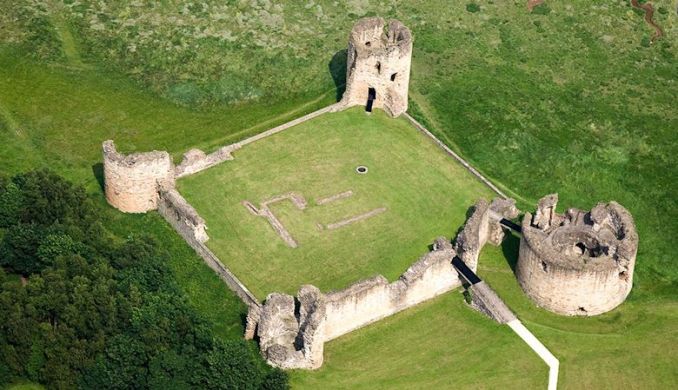
At the same time as Edward secured Flint, an army commanded by his brother Edmund marched out of Carmathen, their destination Aberystwyth. Here Edwards second castle was built. Very little of Aberystwyth castle remain today but we know it was one of Edwards first concentrically designed castles. The complex is built in the shape of a diamond with two sets of walls with large towers at the corners. A large duel towered keep gatehouse was also erected at the castles entrance along with a barbican. Visitors or would be attackers would also have to cross a drawbridge before accessing the gatehouse.
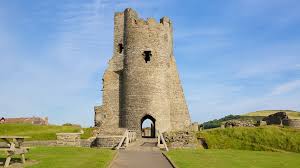
The largest and most impressive of Edwards new castles was founded at Rhuddlan. In keeping with his desire to have all of his castles situated next to the water, Edward embarked on the monumental task of straightening a two mile stretch of the river Clwyd. Situated 10 miles West of Flint, Rhuddlan was built to a similar design as Aberystwyth. As with its sister castle, two sets of walls ensured the best possible defence. The massive internal walls were square in shape and featured two huge twin tower gatehouses and two turreted towers. The outer walls sat lower and were defensible by additional smaller towers. Rhuddlan was a really impressive fortification and this can be seen in the duel tower gatehouse still standing today.
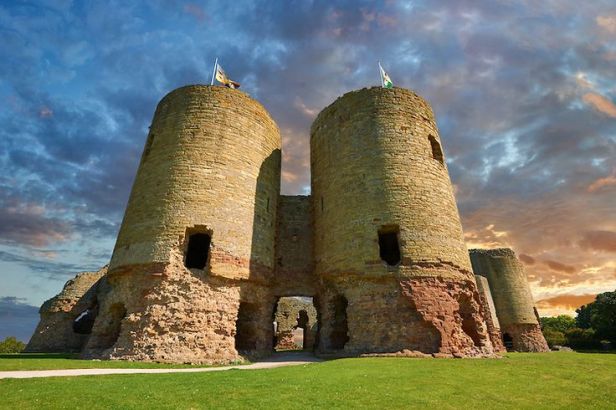
Another castle commissioned at this time by Edward was constructed at Bulith in Mid Wales. Unfortunately nothing of this castle remains today except for the original motte and earthworks. Bulith is actually believed to have been Edwards first Welsh castle and would have been built to a motte and bailie design, but surrounded by two sets of stone walls.
Edward had begun constructing an iron ring of castles around Wales, and it soon became obvious to Llewelyn and his allies that all was lost. Strangely the English king stopped short of total conquest and devised a further peace agreement. Llewelyn was allow to keep many of his lands in Gwynedd and would retain his title Prince of Wales. His position in Wales however was massively undermined. He was very much Edwards bitch now.
In 1282 a further rebellion broke out. The Welsh were unhappy with English rule and tired of having their rights suppressed. Llewelyn and his younger brother Daffyd led attacks on Edwards castles, and Aberystwyth was taken. Naturally Edward was enraged and he again he thought back. A three pronged attack was again utilised with armies marching into North, Mid and Southern Wales. Like in 1276, the Welsh were unable to resist the might of England and Llewelyn was killed. His brother Daffyd suffered an altogether more horrendous fate and was hanged drawn and quartered. And thats a pretty bloody horrible way to go.
Edward had achieved what no English King had done before. The ancient dominions of Wales were now his and he quickly set about asserting his authority. Three new castles were commissioned at Harlech, Conway and Caernarfon. All of these castles would be built next to the ocean and were situated only a days march apart.
The first of the new castles was Harlech. At £8000 it was not exactly cheap, but still the cheapest of the three. Harlech is built upon a naturally defensible outcrop of rock, giving it a really startling and imposing silhouette. As with all of Edwards new castles, his architect Master James gave Harlech two sets of castle walls. These along with the massive gatehouse keep and the internal buildings were all squeezed into a relatively small area. Although its not clear now, in Edwards day the ocean would have come right up to the bottom of the castle. Supplies would have then been brought up to the garrison by a series of steep steps.
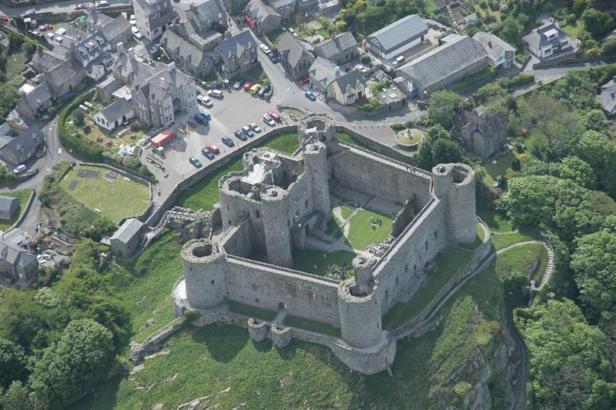
Edwards second mighty castle is situated at Conwy. Perched above a steep platform of rock, the castle overlooks the Conwy Estuary and makes for a truly magnificent sight. Even more sophisticated and cutting edge than Harlech, Conwy castle is easily my favourite. For me this is just the picture perfect fortification and represents everything I love about medieval castles. It almost looks like something you might build on the beach and would have looked even more stunning with its original coat of whitewash. Edward was very much making a statement with Conwy and its no surprise that it was constructed on the site of a cistercian monastery built by Llewelyn’s father. Edward was keen to eradicate anything associated with the previous dynasty and Conwy very much represented the new management.
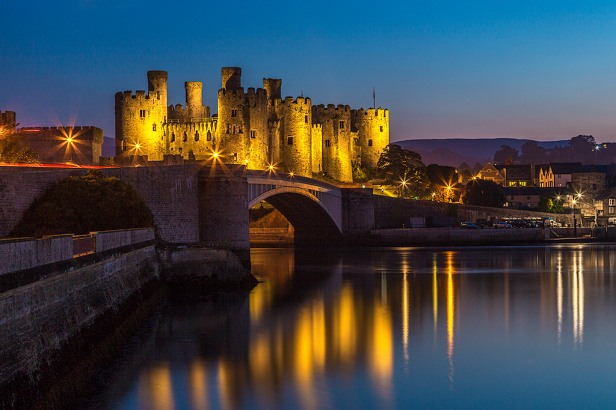
How then, do you better the stunning design of Conwy. How do you improve on perfection. Well Edward and his architect Master James certainly felt optimistic with their flagship fortress at Caernarfon. Caernarfon is so elaborate, so stunning that its hard to believe it was built in medieval Britain. In fact its no surprise that Edward took inspiration from the mighty roman walls at Constantinople. In fact the walls at Caernarfon incorporate branded colour stone and the huge towers are not round, but rather polygonal like those at Constantinople. The design of the complex is also very unique in that it follows a figure of eight shape. This is fact is more to do with the lay of the land and gives the castle a very narrow footprint. Caernarfon really was state of the art.
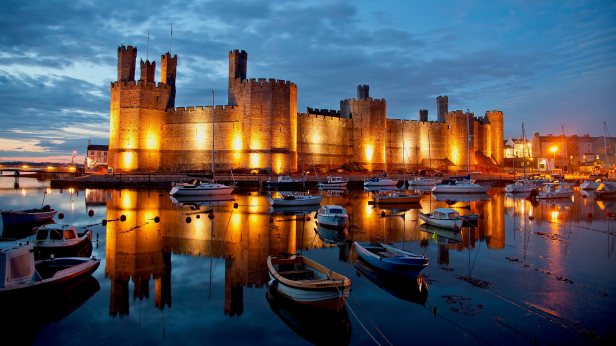
The mighty ‘Kings Gate’ would have seen would be attackers having to cross two drawbridges before passing through duel towers and no fewer than 6 portcullises and 5 solid oak doors. If that wasn’t enough attackers would have been pelted from above by arrows, rocks and god knows what else. This magnificent gate house was not just designed to keep the baddies out however, its use as a ceremonial entrance for royal guests would have been just as important. Although £27000 was thrown at Caernarfon, it was in fact never finished and none of the internal building are left standing today.
Its fair to say then that Edward and his master builder James of St George had become pretty adapt in the art of castle building. Edward had taken the concentric castle design from the relatively modest fortification at Rhuddlan through to the almost perfectly designed fortress at Caernarfon. He had in effect encircled all of Wales with his mighty castles and had, he believed finally subdued the Welsh.
He was not quite there however and a further uprising in 1294 identified a vulnerability in Edwards iron ring of castles. The uprising had originated from the island of Anglesea and it was clear that a further castle was required. Beaumaris on the eastern tip of the island was chosen as the site for the new fortress and for the first time Master James was not limited by the lay of the land. Beaumaris then presented an opportunity like no other and the castle that began to emerge from the marshes was truly and spectacularly fantastic. The castle incorporates two sets of mighty walls, surrounded by a large moat. The design of the fortress is perfectly symmetrical and it incorporates and unusually large court yard capable of providing accommodation for up to 5 Royal households. A deep water dock ensured the garrison could be easily supplied.
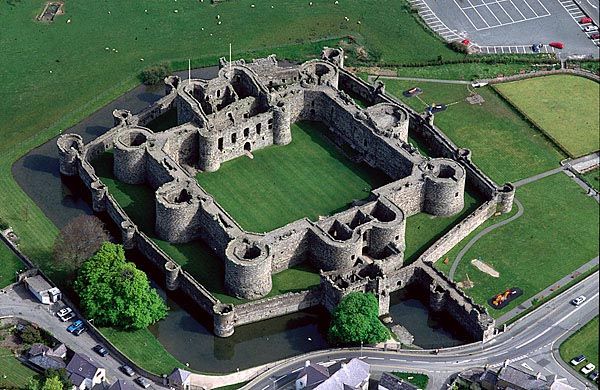
Unfortunately whilst Beaumaris was being constructed Edward was at war with both France and Scotland. Finances were stretched to the limit and this state of the art fortification at Beaumaris was never completed. How we see it today is largely the same as it would have looked when Edward died in 1306. The walls sit at only half of their intended height and none of the internal buildings were every built. What remains at Beaumaris is truly and utterly astounding and even in its unfinished form the castle stands as one of the most impressive examples of 13th century architecture. We can only imagine how it might have looked in its finished form.
The Welsh castles of Edward i stand as a reminder of what the mighty English King achieved in Wales. Not only had he succeeded in finally subduing the Welsh, but the fortresses he built represent the pinnacle of castle building in Britain. Whilst two of his eight castles stand unfinished, it is fair to say that these are some of the most impressive medieval structures still standing in the world today. For me then, this is Edwards greatest legacy.
Check out the video here:
